Bats begin with "b" - Beneficial!
By Dr. Rebecca Christoffel and Marlene Ehresman, Iowa Wildlife Center
October 2014 - Originally written for the Gladys Black Environmental Education Project
Fascinating bats!
Bats make up the second largest group of mammals in the world, with approximately 1,300 described species. Like all mammals, bats have fur, are more or less warm-blooded, and produce milk in mammary glands that is then fed to their young. Unlike other mammals, bats have true wings and can truly fly. Their hands are modified to form their wings, thus the name Chiroptera, or “winged hand” for the order of bats. Their long, slender fingers are joined by two layers of membrane. For some species, their tail is fully connected to their hind legs by a similar membrane, giving them the benefit of a “catcher’s mitt” which aids them in the capture of insects or, in the case of females, catching babies just born.
Bats are found all over the world except for the Arctic, Antarctica, and the highest mountains. Like many groups of animals, the greatest diversity of bats can be found in areas nearest the equator, where food resources are available year-round and the diversity of food resources is greatest.
Bats can be divided into two major groups, or sub-orders. The Megachiroptera are the fruit eating bats. They are found in Australia, Africa, Asia, and South Pacific islands. Scientists refer to these areas as the Old World tropics and sub-tropics. These bats’ doglike snouts have earned them the name of “flying foxes.” These bats are active by day and feed by sight. About 200 species of bats make up this group.
The Microchiroptera is the far larger group of bats, with about 1,100 species. Most of these bats are insect-eaters, but some also eat fish, frogs, lizards, and even blood. Bats in this group have complex nose leaves which aid in echolocation, the method used for finding and hunting their prey. These bats are generally nocturnal and can be found throughout the world in tropical and temperate climates.
Bat Benefits
Globally, bats provide a variety of important benefits. These include their role as predators on insects, frogs, fish, other bats, and other small mammals. Fruit-eating bats are seed dispersers and can be the most important element for reforestation in some parts of the world. Nectar-feeding bats are pollinators that are responsible for some 600 products that are economically important to humans. Bats serve as prey items for animals such as birds of prey, snakes, and other bats. Bat guano (poop) is important as a fertilizer in many parts of the world. Bat caves support a diverse and unique group of organisms, found nowhere else. Dead bats provide food to scavengers and carrion-eating insects such as beetles.
Bats often serve as model animals for medical research. They have contributed to the development of navigational aids for the blind, birth control and artificial insemination techniques, vaccine production, drug testing, and even to a better understanding of low temperature surgical procedures.
Bats have great cultural value. For example, in China, bats are considered lucky and are symbols of longevity and happiness. Bat meat is considered a delicacy in many areas of the world. The great variety of bat species found around the globe adds great beauty to our world.
21st Century Bat Challenges
Bats, like any other group of animals, faces great challenges in the 21st century. Perhaps their greatest challenge is an ever-growing human population. As the number of people increases, but the amount of land available for habitation remains the same, there is less land and less habitat available for bats. Bats have some very specific needs on the landscape, including roosting sites, nursery sites, and appropriate hibernacula (overwintering sites) where the temperature and humidity meet specific, narrow requirements of bats.

A newly emergent fungal disease, white-nose syndrome (WNS) has devastated North American bat populations. First discovered in New York in 2006, the disease has spread to more than 20 states and 5 Canadian provinces. Mortality from WNS varies across bat species but ranges from 50% up to 100% in some caves. It has been suggested that given the disease’s current spread and effects on bats, it may be possible that the little brown bat (Myotis lucifugus) may become extinct within the next 20 years. Click here to learn more about WNS or download a brochure about WNS..
Agricultural and municipal pesticide use can affect bats directly (if they are sprayed with the pesticide) or indirectly by ingesting poisoned prey. Youngsters can die after being fed pesticide-contaminated milk by their mothers.
Many people still view bats as varmints or as sources of human diseases, and bats are often still killed intentionally by people. Bats are also killed accidentally when people who are unaware of their presence disturb bats while they are hibernating, or build fires in caves where bats are overwintering.
Bats are also affected by wind power development. Bats can be killed when flying around wind farms, particularly those farms which are on migration routes for some of the forest dwelling bats, such as red bats and hoary bats.
General Bat Information, Education and Activities Links
- Bats4Kids
- KidZone - Activities
- LiveScience - Facts about bats
- Animal Diversity Web - Bats
- USFWS echolocation video
- Bat Conservation International - Bats 101
Iowa Bats
Few of the estimated 1,300 species of bats make Iowa their home for either all or part of the year, but those that do, are valued for their insect control services. There are three forest-dwelling bats and five cave-dwelling bats that spend at least part of the year in Iowa.
Cave-dwelling bats
The most common cave-dwelling bats found in Iowa is the big brown bat, Eptesicus fuscus. The big brown bat has brown fur and the skin flaps or patagium, is naked and blackish in color. Big brown bats are widely distributed in Iowa and will hibernate in human structures as well as caves. They prefer beetles in terms of diet, and are quite hardy. This species is the last to enter hibernation in the fall and the first to emerge from hibernation in the spring.
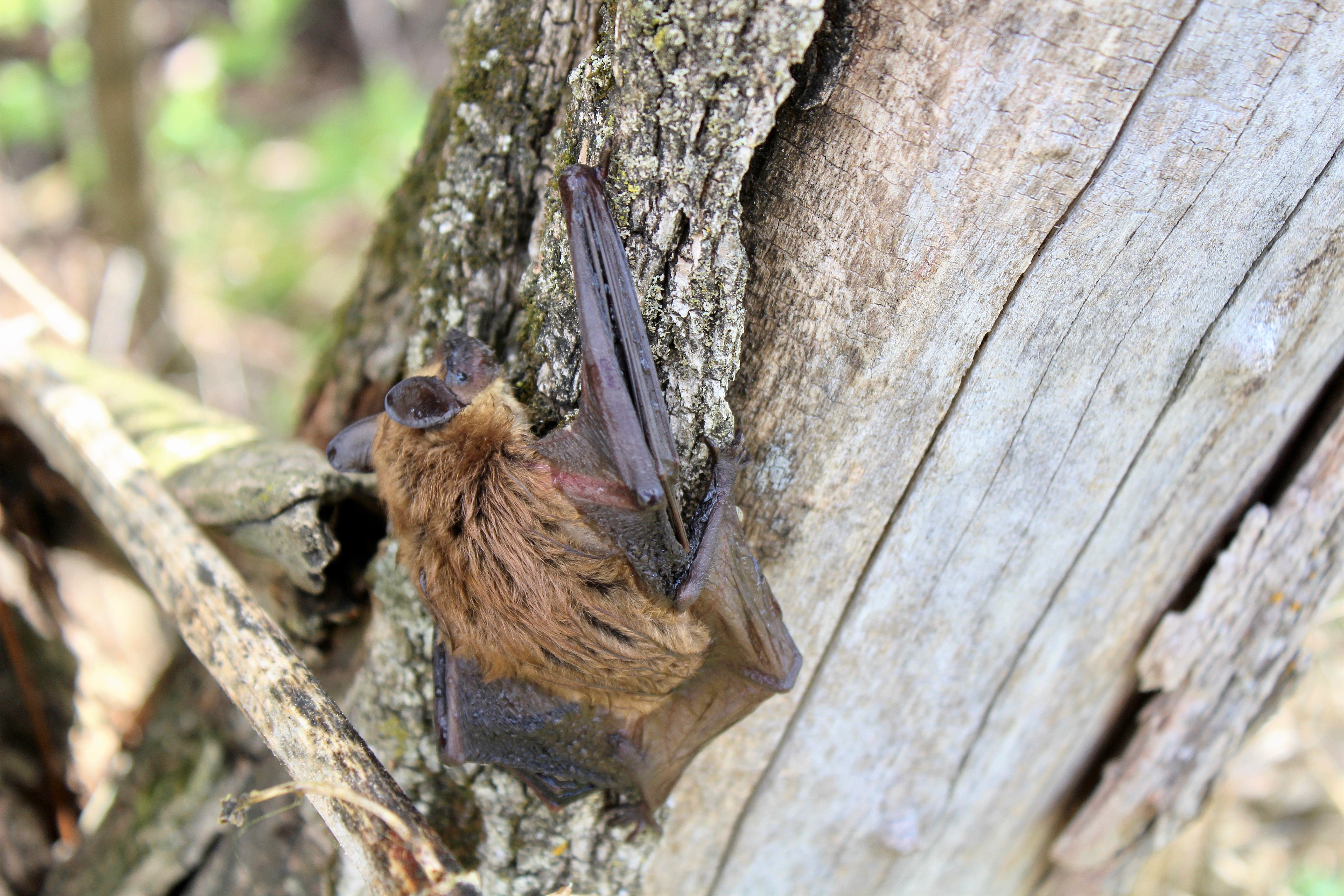
The tri-colored bat (formerly known as the eastern pipistrelle), Pipistrellus subflavus, is the smallest bat found in Iowa. This bat flies somewhat like a giant moth, and has a wingspan of only 8-10 inches. Its fur is yellowish or greyish brown and can be found foraging for insects over waterways and water edges. The tri-colored bat overwinters in caves, mines, and rock crevices. In the summer, both males and females inhabit waterways bordered by woods and usually roost in trees.
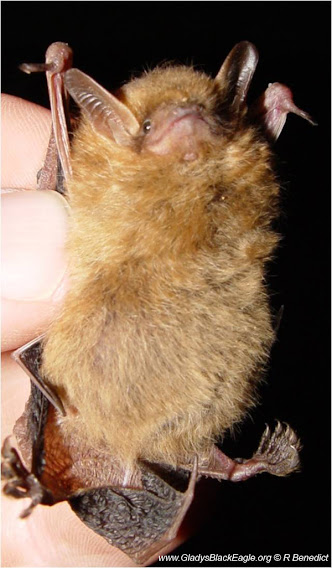
The northern long-eared bat (left), Myotis septentrionalis, and the little brown bat (below right), Myotis lucifugus, are two species that have been particularly hard hit by white-nose syndrome. These two species are currently under consideration for listing under the Federal Endangered Species Act. The northern long-eared bat and the little brown bat are very closely related species that can be difficult to identify unless you have the bat in hand, so it’s not an identification that most people can make. They both have wingspans of 9-11 inches and both can have dark brown fur. However, the ears of the northern long-eared bat are much longer than those of a little brown bat. Another difference between the bats has to do with their behavior. While little brown bats may overwinter in groups of thousands, the northern long-eared bat is much more solitary in its habits, and is generally found singly or in small groups containing up to 100 individuals. In both cases, the bats are long-lived and only produce single pups or occasionally twins each year.
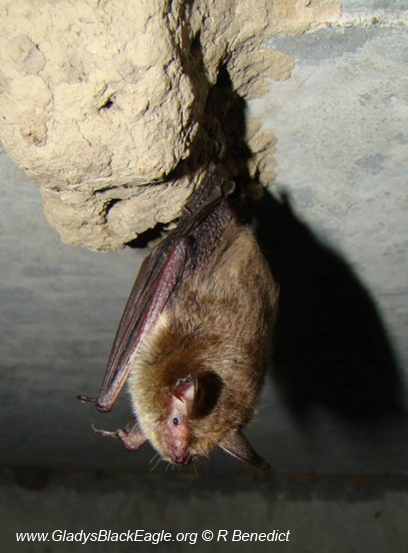

The Endangered Indiana bat, Myotis sodalis, is the only Federally-listed bat found in Iowa. This bat has dull greyish-brown fur above and lighter below. Like the previous two bats, this animal also has a 9-11 inch wingspan, and is hard to differentiate from the northern long-eared bat and little brown bat for most people. Indiana bats spend their time in forests with standing dead trees during their active season, but congregate in a small number of caves overwinter. The Indiana bat is Iowa’s rarest bat and Interstate 80 is as far north as it has been found.

Forest-dwelling bats
The silver-haired bat, Lasionycteris noctivagans, is perhaps the least well-studied bat found in the US. It has blackish fur with silver tips, giving it a frosted appearance. It is slightly larger than most of the cave dwelling bats, having a wingspan of 11-13 inches. These bats are seasonal migrators, often in the company of red bats and small birds. They hibernate in trees, buildings, and rock crevices. Females form small nursery colonies in tree hollows and woodpecker holes. Silver-haired bats are very slow flyers as compared to Iowa’s other bats.

The eastern red bat, Lasiurus borealis, is perhaps Iowa’s most beautiful bat. It is easily distinguished from any other bat you might observe by its beautiful red fur. The fur is white-tipped and its tail membrane, or uropatagium, is completely furred. Like the silver-haired bat, it has a wingspan of 11-13 inches. Red bats have long, narrow wings, short rounded ears, and white markings on their shoulders and wrists. They also undertake long seasonal migrations, and have been observed in groups of up to 100 on these journeys. During the day, red bats hang by one foot from the branch of a tree or more commonly, a shrub such as sumac, with their tails wrapped around them, looking like dead leaves. Red bats live solitary lives, only coming together to mate and migrate. Red bats are especially fond of moths and can sometimes be seen hunting for them around street lamps. Unlike most other bats found in Iowa, the eastern red bat will give birth to up to four youngsters at a time, rather than a single or two pups.
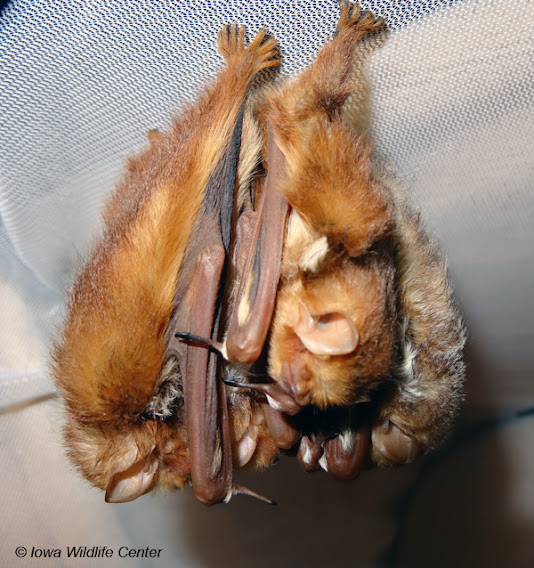
The hoary bat, Lasiurus cinereus, is Iowa’s largest bat, with a wingspan of 13-16 inches. It has yellowish or brownish fur with a frosty appearance due to the white tips on the hairs. The skin of the wing, or patagium, is brownish-black in color, with white patches at the elbow and wrist. These bats undertake long seasonal migrations, sometimes traveling as far south as Panama to spend the winter before returning to Iowa in the spring. Hoary bats often roost in evergreen trees rather than oak, maple, or other deciduous trees. Like red bats, they eat insects, primarily moths, and are solitary except during mating and migration. People seldom encounter hoary bats as they don’t use human structures for roosting or as nurseries for their young.
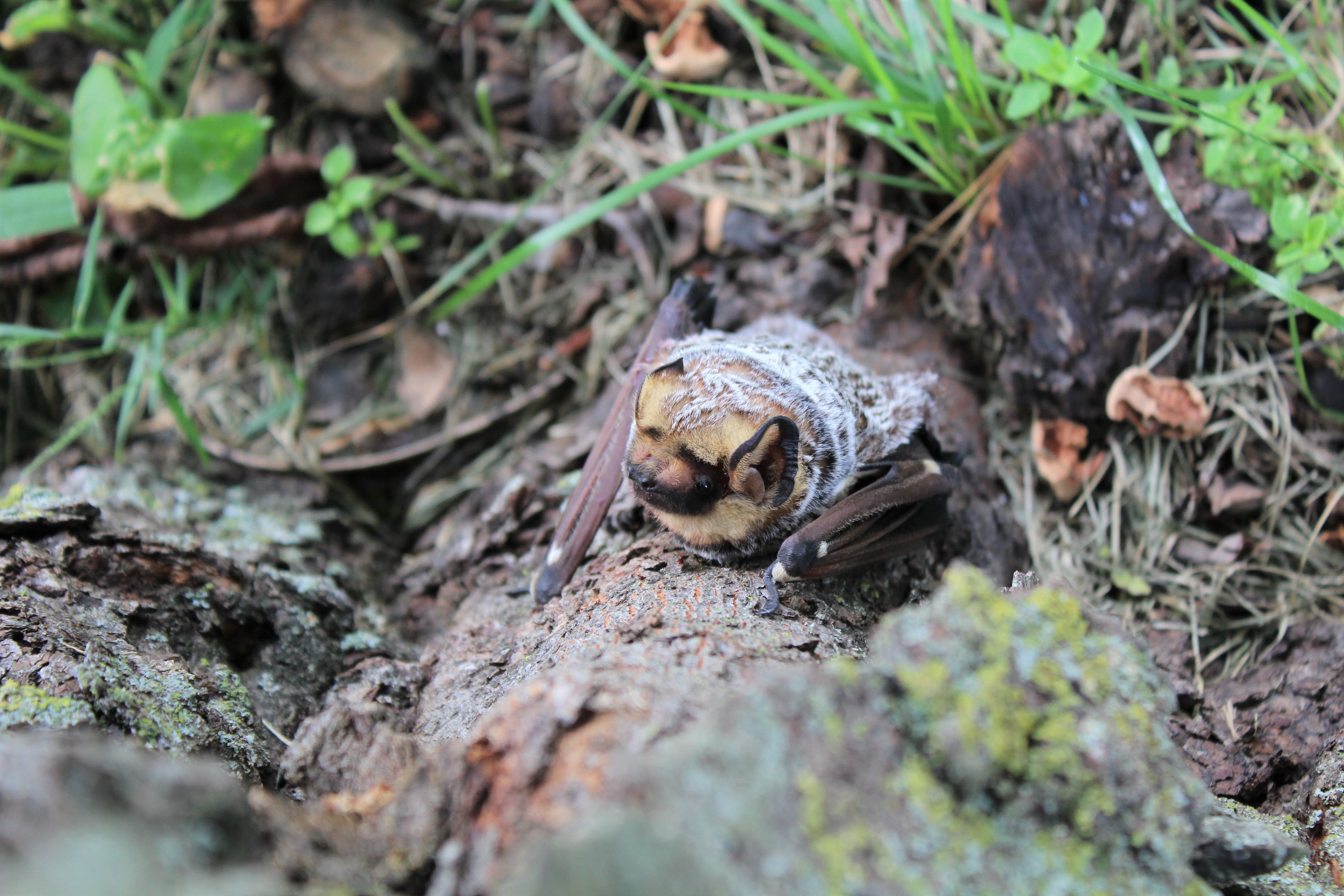
See more Iowa bat photos here!
Iowa bat links and info
- Iowa bat information on Birds of Iowa
- Big brown bat
- Tri-colored bat (formerly known as eastern pipistrelle)
- Northern long-eared bat
- Little brown bat
- Indiana bat
- Silver-haired bat
- Eastern red bat
- Hoary bat
- Iowa DNR Iowa Outdoors Sept-Oct 2008, Night Marauders (opens as PDF)
- Iowa DNR Indiana bat information (opens as PDF)
You Can Help These Amazing Animals!
Help! I Need Somebody!
The Iowa Wildlife Center takes in about 50 bats every year without advertising that we accept this group of animals for their specialized care (think what that number might be if we advertised widely!). What is our year like with just this one species? We get calls year-round from people who are either in a near panic or just don’t know what to do with that seemingly huge and dangerous creature flying erratically inside their home. If it’s warm outside, it’s simple – open all the doors and windows you can, dim your lights and step aside. Their finely-tuned way of “seeing” in the dark, called echolocation, allows them to avoid flying into large objects, like trees and walls and humans, and allows them to precisely snatch an insect out of the air. They’ll sense the opening and happily escape outdoors.
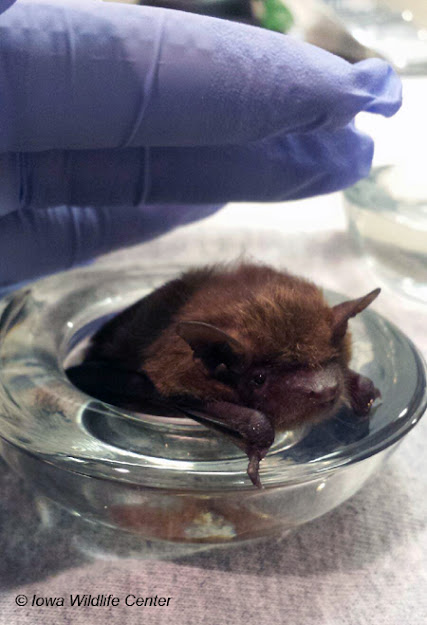
November through March: we primarily receive big brown bats who have roused from hibernation because they are too warm or too cold (40° is optimal) and found their way into rooms inhabited by humans. Only twice in 20 years has another species been brought in during this season, and both times it was a beautiful silver-haired bat. If you find a bat in your house during this period, don’t panic, and certainly do NOT release it outside unless the temperature is well above freezing as their wing membranes are easily frost bitten, usually rendering them permanently incapable of flight. Rather, stay calm, and corral it in the smallest space possible by closing doors. If you want to capture the bat yourself, just don’t get bitten! Find a plastic container and punch nail holes in the lid (any size will do, but a yogurt or cottage cheese-sized container is perfect), put on light leather gloves, wait for the bat to tire and land on a curtain or the floor, and slowly put the container over the bat. Work a piece of cardboard carefully between the bat and whatever it is hanging from, encouraging it into the container. Snap the lid on. Oh, it will be upset, buzzing mightily at you, but don’t let that throw you. It weighs roughly 20 grams! It is likely very hungry and very thirsty and very afraid.
Call or find a local wildlife rehabilitator (opens as PDF) or the Iowa Wildlife Center and we’ll help you get it where it needs to go. (NOTE: while we have never received a “positive” from a bat we have personally submitted for rabies, handling any wild animal is not without risk, and rabies is fatal. Bats, like other mammals, have only about a 1:500 or 1:1000 chance of having rabies. Visit the Iowa Department of Public Health’s website listed below for their recommendations on bats found in the home.)
April and May: There is a bit of a break for us and that’s good because we are busy test-flying the dozens of big brown bats we over-winter in preparation for spring release.
June and July: Bat pups! Baby big brown or little brown bats sometimes either fall from their nursery colony in chimneys, attics or barns, and then crawl their way into our lives. Mother red bats may become grounded in our backyards from the increasing weight of her multiple pups that she carries with her everywhere. There, dogs, cats or children find the distressed family. (It doesn't matter what kind of wild animal we’re talking about. It’s just smart to always keep your pets current on their vaccinations and teach your children to never handle wild animals, but to find an adult to help figure out what to do.) To care for these tiny (often only 4-5 grams), naked creatures, we must give them a species-specific formula, warmth and a mesh-sided pup tent in a stress-free environment. By late summer, they have lost their milk teeth, switched from formula to meal worms and are ready to begin test-flying in preparation for their release. The fall cycle begins again.
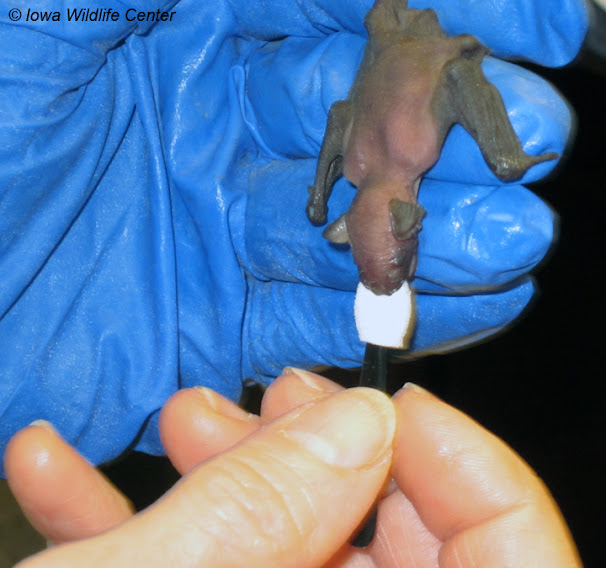
Iowa currently has about 100 licensed wildlife rehabilitators, many of whom do not take in bats of any species or any age. However, this unique network of caring individuals often knows who does rehab or raise bats. Many a bat-finder has driven an hour or two to deliver their bat to the door of the rehabilitator, often handing the rehabber a much-needed financial contribution along with the container.
Batscaping
To manage habitat for bats, there are many steps that landowners can take. Probably the most important thing to keep in mind is that bats need to be kept safe from exposure to pesticides and from potential predators.
Bats eat insects and so by not applying chemical insecticides or herbicides that can secondarily poison insects that feed upon a plant, you can help to reduce the numbers of cases in which bats are either directly or indirectly poisoned by pesticides.
Bats, like all wildlife, need food, water and shelter. If you have moving water on your property, or have a pond on your property, you may find that bats are attracted to it. Some bats, such as little brown bats, often forage along waterways or over water edges.
Many bats use tree cavities as places to roost. If you have dead standing trees on your property, they will provide ready homes for bats. Shagbark hickory trees are like a high-rise apartment, with some bats preferring to seek shelter under the tree’s characteristic shaggy bark. You can help reduce cases of predation on bats by keeping your cats indoors. Outdoor cats may not actually feed on bats, but because cats have a strong hunting instinct, they will hunt down and kill bats when opportunities arise.
If you don’t have trees on your property, but would still like to provide roosting places for bats, you can do so by either building or purchasing a bat box and placing it in an appropriate place.
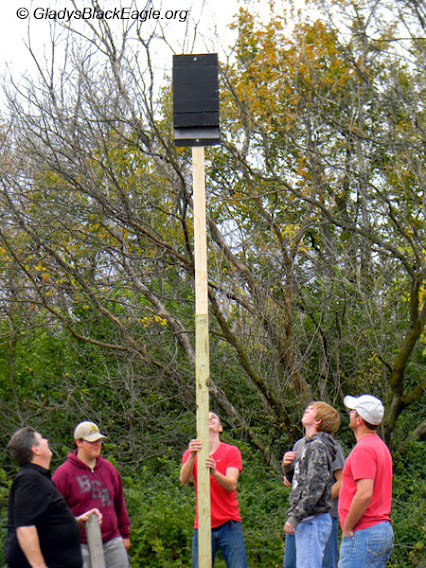
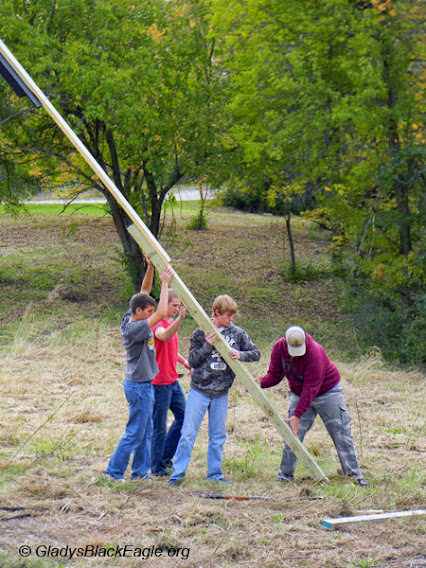
Cris Patrick Schwanebeck (holding the bat house pole in the picture above right) and members of Knoxville Boy Scout Troop 377 erected four bat houses at Marion County Park. Cris Patrick is working on earning his Eagle Scout Award.
How do you humanely remove bats from a building?
Just because it’s the easy way, doesn't mean it’s the right way. Poisons and glue traps lead to horrible, lingering, painful deaths and often kill non-target animals. Batting them with a tennis racket is not easy because they can evade it and it often just breaks their fragile wings. Sometimes, a house may have only one or two “resident” bats in the attic, and many people can live with that; but, sometimes it is a colony. Excluding the bats from your house is the only humane solution and doing it the right time of the year is important. Early fall is the best time, as youngsters are on their own and the colony typically disperses to a different wintering site, or they migrate from the state all together. You can do it in the spring, as long as 2-3 major entries are left open until early fall.
Bat Exclusion
Bat Box Plans
Bat box plans are freely available from a number of reputable sources, including a local Iowa bat conservation organization:

In Iowa, bat houses should be painted a dark color such as navy blue, dark brown, or black with a latex-based paint. Houses need to get at least 8 hours of full daylight and should be placed at least 15’ high.
To reduce predation and facilitate easy take-offs and landings, mount your bat house on a metal pole set out in an open field or on the side of an existing structure such as a barn, shed or house. If you use wood rather than metal for your mounting pole, it is important that a predator guard be used to prevent cats, raccoons, and other climbing predators access to the bats.
If you want to keep bats in your area after you've excluded them from your house, erect a bat box BEFORE you evict the bats. Then you can sit back and enjoy all the benefits of bats.
Vocabulary
- Adaptation: An inherited characteristic that improves an organism's ability to survive. Special tools to do special things.
- Mammal: An animal that has hair and feeds its young milk.
- Echolocation: A series of high pitched sounds made from an animal’s nose and/or mouth that they can interpret when the sounds bounce off of obstacles.
- Guano: Bat droppings.
- Rabies: A deadly disease that affects the central nervous system that is carried by bats.
- Niche: The role of any organism in the environment, its activities and relationships to other living and non-living parts in the environment.
Try this:
Echolocation Activity: "Going Batty," adapted by Kathleen Regnier
To play, have students form a circle. Choose one member of the group to play the role of a bat. Blindfold the bat, and have him or her stand in the center of the circle. Designate two to five other children as moths and have them also come to the center. The object of the game is for the bat to try to tag (or "eat") as many moths as possible. Both the bat and moths can move, but they must stay within the circle. One a moth is tagged, he or she should become part of the circle again.
Whenever the bat calls out "bat," the moths have to respond by calling back "moth." Tell the moths that every time they hear the bat call "bat" it stimulates the bat to send out an ultrasonic pulse to discover what's in its path. The pulse bounces off the moths and echoes back to the bat, stimulated by the moths call "moth."
The bat must listen carefully, concentrate to find out where the moths are, and try to tag them. To add more excitement, two children can be bats at the same time. Just watch to make sure the two bats don't collide with each other. You might want to pick a short and tall child so they don't bump heads.
As another variation, add obstacles by designating several children to play "trees." When the bat calls out "bat" the moths must call out "moth" and the trees must call out "tree." If a bat runs into a tree as it tries to tag a moth, the bat is out.
Batty reading! Look for these and other popular books at your local library!
- Stellaluna by Janell Cannon
- Nightsong by Ari Berk, Illustrated by Loren Long
- Bats at the Library, written and illustrated by Brian Lies
- Bats at the Beach, written and illustrated by Brian Lies
- Bats in the Band, written and illustrated by Brian Lies
published Saturday, October 1, 2022



